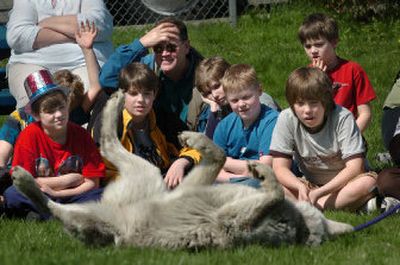Earth Day offers wolf encounter

Maggie elegantly loped in the circle of sitting humans, occasionally stopping to lick a lucky child on the face. Her rear paw always fell in the grass where her front paw had just been.
Her yellow eyes studied her surroundings, and she stopped several times to roll in a particularly good-smelling patch of turf.
Maggie is one of 33 captive wolves that Kent Weber and his wife, Tracy Brooks, have rescued to their Mission: Wolf, a remote refuge near Silver Cliff, Colo.
Weber refers to Maggie as “the ambassador wolf” because she is the only wolf with a demeanor that allows him and Brooks to bus all over the country with her, letting schoolchildren and adults touch one of nature’s most mysterious, misunderstood and intriguing predators.
And Maggie was an absolute hit on a gorgeous Saturday for Coeur d’Alene’s seventh annual Earth Day celebration at the Harding Family Center.
Keira Hale, of Hauser, remained still and closed her eyes as Maggie approached. The 4-year-old gray wolf extended her muzzle and licked Hale’s face.
“It was so cool,” Hale said. “I love wolves. They are so beautiful.”
Weber said he grew up in Wallace before moving to Silver Cliff, Colo., where he keeps the wolves, which can never be released into the wild.
As Maggie made her rounds on a long leash held by Brooks, Weber explained to the children that wolves’ brains are 30 percent larger than dogs’, and how they are drawn to children much like they are drawn to wolf puppies.
Weber asked the crowd to stay seated so that Maggie would not become intimidated. He was also careful to instruct the children not to turn and run.
Weber said that as a child, he was told wolves would be extinct in Idaho during his lifetime. Yet wolf reintroduction has been so successful here that other states and countries are copying Idaho’s efforts.
“You are so lucky to live here,” Weber said. “It’s one of the last best places to see a wolf.”
Maggie weighs 87 pounds, but adult gray wolves typically weigh between 120 and 140 pounds, he said. Their favorite prey animals are elk and deer.
In Yellowstone National Park, the wolf recovery has had several unintended consequences. For decades elk have grazed off young trees. Now that wolves have returned to the park, young trees have also begun to take hold, which helps provide shade to keep streams cool for trout, Weber said.
The wolves have also reduced the coyote population, which has helped antelope herds.
But he also told the story of the wolf’s destruction and eradication from most of the country. Wolves are legally hunted in Alaska, he said.
“Everyone has something to say about a wolf,” Weber said. “To have this many people show up (on Saturday), it’s like a change in the tide.”
Several hundred kids and parents filed through the Harding Center, where for $3 they could take a picture with a live owl or learn about pollution by throwing sandbags through a hole to win a prize.
Jeff Reade, of Hayden, was a walking jungle gym for his 4-year-old son Charlie and 2-year-old son Max. Both boys were inside the wolf ring, but Maggie did not provide the kiss they wanted.
“The wolf was cool, but we would have come here to celebrate Earth Day anyway,” Reade said. “The environment has to be our No. 1 concern if we are going to exist on this globe together.
“We need to take care of it for our children and their children.”